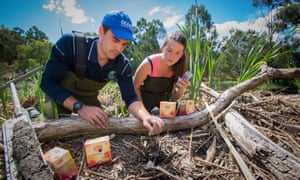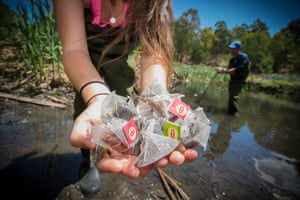Source: theguardian.com
Published: February 2, 2017

Deakin University researcher Peter Macreadie and PhD candidate Katy Limpert bury the first of 50,000 teabags which will be placed in wetlands around the globe as part of a world-first project to monitor carbon sequestration and breakdown. Photograph: Simon Peter Fox
Citizen scientists are being sought for a project which will see tens of thousands of teabags buried in wetlands to monitor carbon sequestration
Australian scientists have launched a project to bury tens of thousands of teabags in wetlands around the world. They are hoping others will sacrifice a few cups of tea and join in to discover how efficient different wetlands are at capturing and storing carbon dioxide.
Lipton green tea and red tea “rooibos” varieties will be used in the project, which already involves more than 500 scientists in every continent except Antarctica.
Leader of the project, Peter Macreadie from Deakin University’s Blue Carbon Lab, said wetlands were important for carbon capture and storage, a process known as carbon sequestration, holding up to 50 times as much carbon by area as rainforests.
“But some wetlands are much better at carbon storage than others, and some are in fact carbon emitters, so they’re not all fantastic,” Macreadie said.
“We need to find out the best wetland environments for carbon sequestration so we know where we should invest our energy.”
That’s where scientists have come up against barriers in the past. There are hundreds of thousands of wetlands around the world. A standardised technique for monitoring the carbon is needed for accurate comparison, and monitoring devices can cost thousands of dollars to install.
But Macreadie had been reading scientific research about teabags being buried and used to measure the rate at which carbon was being released from soil into the atmosphere.
Fast decay of the tea inside the bag meant more carbon was being released into the atmosphere, while slower decay meant the soil was holding the carbon.
“I thought, ‘Jeez this is a bloody good idea. Why aren’t we using it in wetlands?’” Macreadie said.
“People think of innovation as involving fancy new technology, but sometimes the best ideas are the most simple ones.”
Lipton teabags are being used because they are already favoured by international researchers studying terrestrial carbon sequestration. They also have a fairly standard rate of decay in wetlands and the required tea varieties are sold around the world.
Lipton teabags are being used in the research as they have a fairly standard rate of decay in wetlands. Photograph: Simon Peter Fox
Lipton are giving the researchers 50,000 teabags. Macreadie and his team this week began burying the bags at Gardiners Creek wetlands and Western Port Bay in Victoria.
The project coordinator, Stacey Trevathan-Tackett, said the green tea aroma and the slight hint of spice in the rooibos masked the smell of the mud as she embedded the bags in the swamp. She inserts a shovel into the ground at about 10cm depth and creates a wedge to drop the teabags into. The teabags are numbered and labelled, and a GPS point is taken down.
Between 40 to 80 teabags are buried per site.
“We’re using the green tea and red tea because they’re made of different components, with green tea degrading more quickly and so we expect it not to last as long, while the red tea is made of tougher components and will break down more slowly,” she said.
“If we have these two teas out there in the same environment we can examine how they degrade comparatively to each other and also in comparison to other environments.”
The bags will be monitored over a three-year period and will be dug up and measured at intervals of three months, six months and each year after that.
Once researchers can establish which wetlands are most effective at carbon sequestration, work can begin on protecting those types of wetlands, restoring them and ensuring they are not disrupted, Macraedie said. Destruction of wetlands could see thousands of years worth of ancient carbon released into the atmosphere in just a few months.
“Wetlands to many people are the armpits of our environment,” he said.
“A lot of people don’t like these environments of mangroves and seagrasses, and we’ve drained them for aesthetic and agricultural reasons, we’ve built roads, airports and football ovals on top of them, and we’ve removed tens of thousands of them without knowing their importance.”
Those who contact the Blue Carbon Lab wanting to participate and who have a wetland near them will be sent a kit containing teabags and information on how to bury them. Currently the researchers leading the project are doing the work without funding – aside from the cost of the teabags being covered by Lipton. They hope as their work goes global more funding will be forthcoming.
“We also hope that by encouraging professional and citizen scientists to contact us and spread word about this project, other people will begin to understand the importance of wetlands to biodiversity, in carbon sequestration, and in mopping up pollution,” Macreadie said.
The executive director of the Global Carbon Project and scientist with the CSIRO, Pep Canadell, described the initiative as “a great idea”.
“Wetlands are extremely threatened around the world, so anything we can do to highlight their benefits to society will certainly give us more ammunition to convince agencies, and government and non-governmental groups to put resources towards their conservation,” he said.

